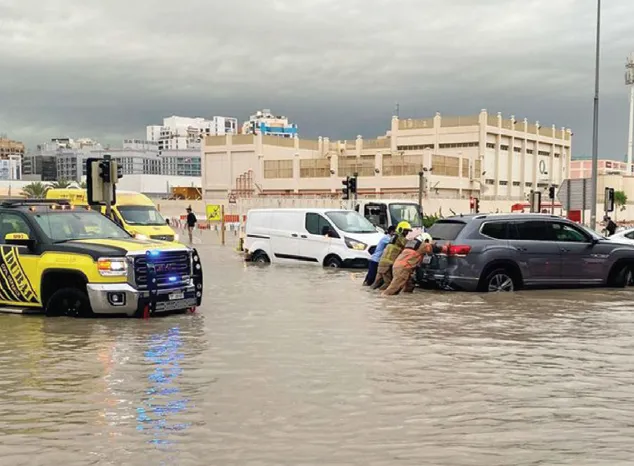It was horrific to see the images of devastating floods in Dubai, the desert city of the United Arab Emirates this week. Cars floated in the flooded streets of Dubai as people and rulers watched with sheer helplessness.
Living in an eco-fragile Himalayan region, we must draw lessons from the devastating floods in the UAE. The bottomline is that the power of nature is ultimate. We can’t play with nature and get away!
UAE is one of the most developed countries. It received its highest rainfall in 75 years on April 16. The country receives scanty rainfall and the downpour received in a day is said to be equal to two years’ of rainfall.
Dubai receives less than 100mm of rain in a year on an average. In the city of Al-Ain about 256mm of rain was recorded in just 24 hours.
Imagine the devastation coupled with lack of adequate drainage and dewatering systems in the desert region especially Dubai. People were trapped in luxurious apartments in Dubai skyscrapers. It must have been like a nightmare for them to see bustling streets turn into gushing streams!
Experts are grappling with different theories on triggering heavy rains in the UAE. Some suspect Cloud Seeding by authorities behind the record downpour. As rainfall is scanty in the world, the authorities in the UAE, one of the hottest regions, to tackle water shortage, use a process called Cloud Seeding for rains. Under the complex process chemicals are implanted in clouds to trigger precipitation. With the help of an aircraft, salts like silver or potassium iodide are dropped into clouds to condense water vapour and turn it into rain.
However, UAE’s meteorology agency has claimed that they didn’t conduct Cloud Seeding before the storm. It is a matter of investigation whether frequent Cloud Seedings in UAE is disturbing its natural eco-system.
Experts do blame climate change as one of the probable causes of heavy rains in the UAE. They state that rainfall from thunderstorms in UAE is due to convection. They explain that rainfall is becoming heavier across the globe as the climate warms because a warmer atmosphere can hold more moisture.
According to a study, annual rainfall could increase by up to about 30 percent across the UAE by the end of the century as the world continues to warm. Dubai is fast losing its minimal green spaces to concrete structures. There is negligible green space to absorb moisture from air. It is a classic example of haphazard development!
Back home, J&K has been witnessing erratic climatic patterns for the last few years. We had dry and warmer weather in the peak winter period this year. The problem is compounded by rapidly melting glaciers, unabated pollution and encroachments of water bodies and vanishing flood plains especially in Kashmir.
Dubai deluge must bring alive bone-chilling memories of devastating floods in September 2014 in Kashmir when river Jhelum overflowed, following incessant rains and cloudburst. But we have short memories and don’t learn lessons! Even after floods a decade ago, unscrupulous people have been undertaking massive constructions in areas which were part of river Jhelum’s flood plains.
Human greed has reached to such an extreme level that even mountains, forests, wetlands and water bodies haven’t been spared! Jhelum which drains Kashmir’s waters overflows after a day of rains as it has lost its carrying capacity.
Environmentalists have been crying that increasing human activities in eco-fragile areas coupled with global warming will spell doom on glaciers in J&K. Rapid retreating of glaciers is bound to severely affect ecological balance besides food, energy, and water security in J&K. As a matter of concern, fast retreating of glaciers has created glacial lakes in various mountain ranges of J&K besides Ladakh. There is imminent risk of Glacial Lake Outburst Floods which can be disastrous for downstream populations.
J&K and Ladakh house some of the largest glaciers in the Hindu Kush region. Kolahoi, the largest glacier of Kashmir’s Jhelum Basin, is retreating rapidly due to a spurt in temperature triggered by global warming and extreme pollution. Thajiwas, Hoksar, Nehnar, Shishram, and glaciers around Harmukh are melting fast. Studies indicate that Kolahoi, the largest glacier of Kashmir Valley’s Jhelum Basin, is retreating rapidly due to a spurt rise in temperature triggered by global warming and extreme pollution.
Environmentalists blame unprecedented increases in temperature, deforestation, increasing human activities, constructions in eco-fragile zones and high levels of pollution caused by the emission of greenhouse gases by vehicles, brick kilns and cement plants for the retreating of glaciers in J&K.
A latest study states that 122-glaciers situated in the Pir Panjal range of Kashmir basin are on a shrinking spree. Glaciologists based on studies state that during the last few years, glacier melting in Kashmir and Ladakh region has been highest as compared to the rest of the Himalayas and the Alps.
J&K ranks 3rd among the Himalayan areas which are vulnerable to climate change. There is massive disturbance in our forests forcing wild animals to move towards human habitations. This has resulted in rising cases of human-wildlife conflict.
There are clear indicators of negative changes in our eco-system due to haphazard development. We need to wake up from slumber and understand climate change vulnerabilities. We need to understand how climate change brought a developed and bustling country like UAE to a standstill with a day of rain. J&K is more vulnerable to climate change.
We must join hands to adopt strategies for preserving the environment. Sooner the better! Otherwise we have to be ready for ecological disaster!
Author is Executive Editor, Greater Kashmir







